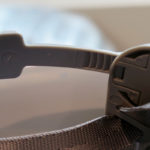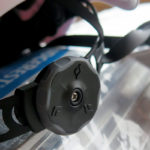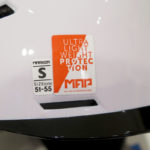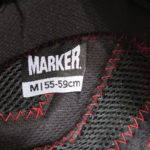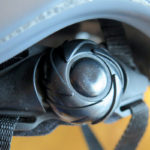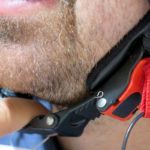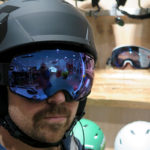Measure head circumference with a tape measure
To measure the circumference of your head (also known as hat size) you will need a tape measure or alternatively a string and a meter ruler.
- The measuring tape is placed horizontally around the head about one centimetre above the eyebrows and ears over the forehead (not at the top of the hairline!). One hand fixes the end, the other guides the tape measure.
- The tape measure should fit snugly but not cut into the skin.
- You should be able to read the circumference of your head directly from the intersection of the tape measure.

If you use a string as a measuring aid, place it in the same way as the tape measure and mark the intersection point. Then take the measurement, the distance from the beginning to the mark, with a ruler or metre rule and thus determine your head circumference.
The hat size also counts for beanies, caps and headbands
The sizes in which outdoor hats, beanies, headbands or baseball caps are available for purchase are purely a matter for the manufacturer. If the headwear is available in S, M, L or even double sizes such as S/M, you will find the corresponding head circumference in the manufacturer’s size tables next to the product. However, many manufacturers also use the one size or uni label. Such models are usually made for an “average head” and range somewhere between 54 and 56 centimetres for women and 58 to 60 centimetres for men. Here, too, there may be a manufacturer-specific specification. Finally, beanies and headbands are usually stretchable and caps are often adjustable through a snapback, Velcro or similar closure system.
Size chart hats, caps and headbands (hat size)
The following general size chart for hat sizes serves as a guideline for textile headwear for which no explicit manufacturer specifications are available. Where specific tables are available, you will find them in the Bergzeit Shop under “Size Chart” for the respective product.
International hat sizes
| Unisex-Sizes | XS | S | M | L | XL |
| Head circumference in centimetres | 53-54 | 55-56 | 57-58 | 59-60 | 61-62 |
The standard for unit sizes
| Uni / one size | Women | Men | Unisex | Kids |
| Head circumference in centimetres | 54-56 | 58-60 | 56-58 | 50-55 |
What’s the deal when sizing helmets?
When buying a bicycle helmet, ski helmet or climbing helmet, the first thing to do is to measure your own head circumference. You can read how to do this in the section “Measuring head circumference with a tape measure”. Then it’s time to look for the right product. The size of a helmet is usually indicated on the inside or outside of the helmet. Most models have an adjustment system that offers a few centimetres of play.

Nevertheless, it is important to choose the perfect size already at the time of purchase. On the one hand, even the size adjuster will reach its limits at some point, and on the other hand, only a really well-fitting helmet protects against injuries. If the helmet is too big, in the worst case it slips off in an accident and no longer protects the head adequately. A helmet that is too small, on the other hand, does not fit the head at all and causes unpleasant pressure points.
Many helmet manufacturers do not always use the centimetre specification when labelling their products. Often seen is also the international labelling with S, M, L or double sizes like S/M or L/XL. Unfortunately, there is no uniform standard that specifies which measured value corresponds to the respective size information. Therefore, before buying, you should find out exactly what, for example, the label S/M means for the respective manufacturer you might be interested in. You can find manufacturer-specific size charts in the Bergzeit Shop l with the respective product under the “size chart”.
- Tipp: If the determined head circumference is between two sizes (e.g. 59 centimetres for M (57 to 59 centimetres) and L (59 to 61 centimetres), we recommend choosing the larger size.
How should a helmet fit?
Unlike caps, which everyone can pull more or less far into their face according to their personal style, a helmet should actually sit rather horizontally on the head. The helmet width must be adjusted to the head circumference by means of an adjustment system (e.g. turning wheel or ratchet).
- Self-check: An optimally adjusted helmet should stay on your head even with the chin strap open if you shake it vigorously or slowly lean forward.
Next, adjust the chin strap. The side straps should run neatly past the ears and cross underneath. Once the buckle is closed, it is recommended to have about a finger’s width of air under the chin to allow sufficient room for movement.
- Self-check: With the chin strap correctly adjusted, a well-fitting helmet should now no longer be able to be pulled back off the head or turned sideways.
Tip: Goggles and helmet must become a unit!
With sports helmets, it is also important that they are compatible with the glasses. Not every pair of ski goggles fits every ski helmet, and bicycle helmets may not harmonise optimally with every pair of sunglasses. Ski goggles should therefore be fitted to the helmet in such a way that there are no unpleasant cold bridges or overlaps. Find out more about this in our shop guide for ski goggles. When wearing cycling glasses, make sure that the combination of helmet and glasses does not create any pressure points.
Head circumference and helmet sizes for children
For children’s helmets, the circumference of the head is also the basis for selection. As described above, measuring is easiest with a tape measure, if necessary in front of a mirror so that the child can watch or even help.
- Important: Even though children’s heads grow rapidly, especially in the first years of life, it is absolutely necessary to choose the right helmet size. If you want to save money and let your child “grow into” a helmet that is too big, you risk the safety of your child. Only a well-fitting, well-adjusted helmet can offer reliable protection.

When choosing a size, it makes sense to try on the helmet with a thin cap, because children often wear these under their helmets in the colder months of the year. The adjustment range should therefore offer enough leeway to sit optimally on the head with and without a cap. Important: Always adjust the settings if necessary!
In addition to an optimal fit – no slipping to the side or back – it is recommended that children’s helmets should be easy to use with the adjustment system and the buckle, lightweight and of course also look the part. Only if the child likes the climbing, cycling or ski helmet will he or she be happy to wear it.
Summary on sizing advice for caps, helmets & co.
Ideally, only suitable headgear looks good AND fulfils its purpose – be it a cap for sun protection, a beanie against the cold or a helmet to protect against injuries. One’s own helmet, hat or cap size can be easily determined based on the circumference of your head. As there is no standardised system for marking helmet sizes (just as there is for clothing), it is best to compare the measured value with the manufacturer’s specifications.
